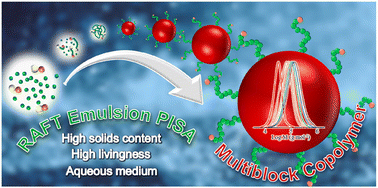Multiblock copolymer synthesis via aqueous RAFT polymerization-induced self-assembly (PISA)†
Abstract
Reversible addition–fragmentation chain transfer (RAFT) polymerization-induced self-assembly (PISA) emulsion polymerization is used to prepare multiblock copolymers. Initially, well-defined polystyrene seed particles are synthesized with high livingness, followed by sequential seeded RAFT emulsion polymerizations to yield high molecular weight (>100 000 g mol−1) hexablock multiblock copolymers. A polystyrene homopolymer hexablock was prepared to serve as a model system, and a hexablock copolymer composed of polystyrene and poly(butyl methacrylate) blocks was also successfully prepared to highlight the ability to synthesize multiblock copolymers of chemically incompatible monomers. RAFT PISA emulsion polymerization involves the in situ generation of an amphiphilic species in a heterogenous system as opposed to a two-step pre-synthesized amphiphilic species in hitherto used approaches. As a result, the system has a higher livingness and high solid content (>30%) can be obtained. The simplicity of the system coupled with the environmentally friendly medium increases the feasibility of industrial scale up.



 Please wait while we load your content...
Please wait while we load your content...